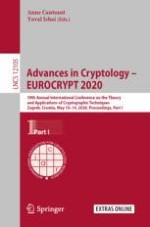The three volume-set LNCS 12105, 12106, and 12107 constitute the thoroughly refereed proceedings of the 39th Annual International Conference on the Theory and Applications of Cryptographic Techniques, EUROCRYPT 2020, held in Zagreb, Croatia, in May 2020.
The 81 full papers presented were carefully reviewed and selected from 375 submissions. The papers are organized into the following topical sections: invited talk; best paper awards; obfuscation and functional encryption; symmetric cryptanalysis; randomness extraction; symmetric cryptography I; secret sharing; fault-attack security; succinct proofs; generic models; secure computation I; quantum I; foundations; isogeny-based cryptography; lattice-based cryptography; symmetric cryptography II; secure computation II; asymmetric cryptanalysis; verifiable delay functions; signatures; attribute-based encryption; side-channel security; non-interactive zero-knowledge; public-key encryption; zero-knowledge; quantum II.


